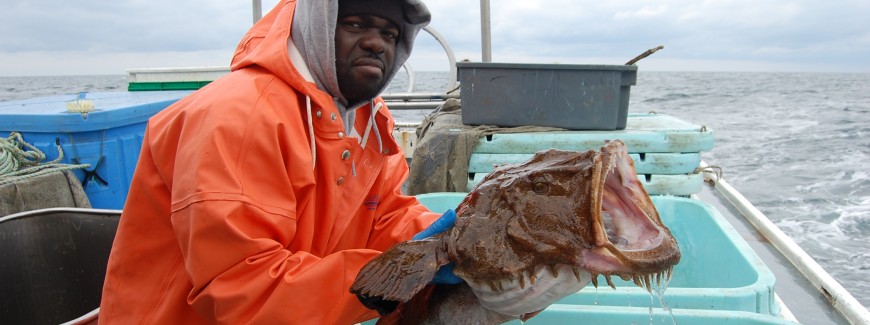Top photo: NOAA monkfish assessment
The message from Jon Hare, the director of the National Marine Fisheries Service’s (NMFS) Northeast Fisheries Science Center (NEFSC) was as distressing as it was clear:
I have raised at both [the New England Fishery Management and Mid-Atlantic Fishery Management] Council meetings the issue that the NEFSC is not going to be able to complete assignments as scheduled in 2025. This is a result of staff reductions that have occurred and will occur in the coming weeks…
The NEFSC is looking at these two time scales—2025 and 2026 and beyond. For 2025, the NEFSC is evaluating the 2025 assessment schedule and associated process steps to try and determine what is feasible given the reductions in staffing. The NEFSC will be reaching out soon to discuss proposed changes to assessment product delivery for 2025 to meet management needs with our decreased assessment capacity…
In our early planning, NEFSC recognizes that two “new-ish” process steps will need to be paused for the time being. First, we intend to not conduct the proposed Management Track input process that was intended for May 2025 to gather input on Fall 2025 [Management Track] assessments. Given that we do not have clarity on what the assessment schedule will look like for 2026 and beyond, we feel it does not make sense to convene stakeholders to gather input on assessments that may not happen in 2026. Second, we also do not intend to convene a Research Track Steering Committee meeting this Spring. Similar to the [Management Track] input situation, once we have an idea on our capacity, we are going to ask the [Northeast Region Coordinating Council] to consider the current Research Track schedule at our May meeting, so planning for additional Research Tracks is premature at this time.
…With respect to assessment schedule changes, NEFSC is actively developing proposed updates for 2025 to discuss with you. As soon as possible, we will reach out to share those ideas and work on solidifying this year’s schedule. Once we’ve done that, we’ll move onto longer-term planning, and will be engaging NRCC members in that as well—with hope that we’ll have some concrete ideas to discuss at the May NRCC meeting.
Thank you.
The note was addressed to members of the Northeast Regional Coordinating Council, an organization composed of scientists and fisheries managers from the NEFSC, NMFS’ Greater Atlantic Region Fisheries Office, the New England Fisheries Management Council, the Mid-Atlantic Fisheries Management Council (MAFMC), and the Atlantic States Marine Fisheries Commission (Commission), which was organized to “prioritize, communicate, and coordinate fisheries scientific and management resources through in-person meetings that include Federal, State, Council, and Commission managers and scientists of the Greater Atlantic region of the United States.”
Dr. Hare’s message bodes ill for the fishery management system now in place throughout NMFS’ Greater Atlantic region, which includes all federal waters between northernmost Maine and Cape Hatteras, North Carolina. It also bodes ill for some stocks managed by the Commission which, while primarily pursued in state waters, are nonetheless assessed by the NEFSC.
Fisheries management in the Greater Atlantic region, as in all other federal waters, is governed by the Magnuson-Stevens Fishery Conservation and Management Act (Magnuson-Stevens), which has established a number of legally enforceable requirements for all federal fisheries managers and federally managed fisheries. Magnuson-Stevens requires that “Any fishery management plan…with respect to any fishery, shall contain the conservation and management measures…necessary and appropriate for the conservation and management of the fishery to prevent overfishing and rebuild overfished stocks, and to protect, restore, and promote the long-term health and stability of the fishery. [formatting omitted]”
It defines “overfishing” and “overfished” as “a rate or level of fishing mortality that jeopardizes the capacity of a fishery to produce the maximum sustainable yield on a continuing basis.”
Should a stock be found to be overfished, Magnuson-Stevens requires that fisheries managers prepare a rebuilding plan that, among other criteria, “specif[ies] a time period for rebuilding the fishery that shall be as short as possible…and not exceed 10 years, except in cases where the biology of the stock of fish, other environmental conditions, or management measures under an international agreement in which the United States participates dictate otherwise. [formatting omitted]”
Magnuson-Stevens also requires that “Conservation and management measures shall be based upon the best scientific information available.”
The stock assessments provided by NMFS’ fisheries science centers, including the NEFSC, have long been recognized as the “best scientific information available” for managing fish in federal waters. Without timely assessments, it would be impossible to determine the maximum sustainable yield (MSY) of any fish stock, nor the fishing mortality rate that would achieve MSY but not lead to overharvest.
Without such assessments, it would be impossible to determine whether a stock is overfished or experiencing overfishing, or to determine whether a formerly overfished stock had been successfully rebuilt. And the management plans for some fish stocks require even more intensive monitoring.
On June 7, 2022, the MAFMC and Commission jointly adopted the Recreational Harvest Control Rule Framework (Control Rule), which was more formally designated Framework 17 to the Summer Flounder, Scup, and Black Sea Bass Fishery Management Plan and Framework 6 to the Bluefish Fishery Management Plan. The Control Rule was amended by the MAFMC and Commission on April 9, 2025.
The Control Rule abandoned the traditional approach to recreational fisheries management, in which anglers’ recent landings were compared to an established recreational harvest limit (RHL). Depending on whether such recent landings were above or below the RHL, recreational management measures were made either more or less restrictive in the hope to make landings more closely approximate the RHL in the next fishing year.
It was a simple process, but because weather, the availability of different species, and even economic factors such as fuel prices affected angler behavior differently each year, and because the estimates of recreational landings included substantial uncertainty, it was rarely successful in aligning landings with the RHL.
The Control Rule presented a new approach that was, in part, based on stock status. Given the same set of circumstances, different management responses would occur depending on whether a stock’s abundance was “very high,” or more than 150% of the biomass target (Btarget); “high,” defined as at least 100% of Btarget but less than 150%; or “low,” meaning at least 50% of Btarget but less than 100% (the recent amendment to the Control Rule changed those definitions somewhat, and added a fourth category for stocks with an abundance just a little above or below Btarget). Control Rule-based management measures would remain in place for two years to better promote regulatory stability, and substantially dampened the sometimes wild, year-to-year changes in management measures adopted pursuant to the previous approach.
However, the Control Rule is heavily dependent upon timely stock assessments, produced every two years, to inform managers of changes in a stock’s status. In 2023, after a scheduled research track stock assessment for black sea bass could not be completed on time, and so delayed the production of a management track assessment needed to inform the Control Rule process, the process of setting recreational black sea bass specifications for 2024-2025 was disrupted. A memorandum from MAFMC staff advised that
The [Control Rule] is intended to allow recreational measures to remain unchanged across two years, aligned with the timing of updated management track stock assessments, which are expected to be available every other year. However…the previously anticipated 2023 management track assessment was postponed to the summer of 2024.
Given this change in the timing of the assessment, the 2024 overfishing limit, acceptable biological catch limit (ABC), recreational annual catch limit (ACL), and recreational annual catch target (ACT), from which the RHL is derived, were all set equal to the 2023 values. The 2024 RHL (6.27 million pounds) differs from the 2023 RHL (6.57 million pounds) only due to the use of updated discard data in the calculations. Framework 17/Addendum XXXIV did not contemplate a situation where the RHL would change without updated stock assessment information… [emphasis added]”
Because black sea bass abundance was deemed “very high,” and because 2024 recreational landings were expected to exceed the 2024 RHL, the Control Rule called for new management measures that would effect a 10% reduction in recreational black sea bass landings.
The Summer Flounder, Scup, and Black Sea Bass Monitoring Committee (Monitoring Committee), which is composed of state, Commission, and federal biologists and advises the MAFMC and Commission on management issues, disagreed with the Control Rule’s direction.
Instead, the Monitoring Committee “agreed that the [Control Rule] requirements in this situation are not clear. The framework/addenda which implemented the [Control Rule] did not contemplate a situation where the RHL would change without a stock assessment update. When the framework/addenda were finalized, it was assumed that management track stock assessments would be available every other year.” Because the required stock assessment was unavailable, and after considering multiple factors that fell outside the Control Rule’s methodology, “but with greatest emphasis on the lack of updated stock assessment information,” the Monitoring Committee “recommended that recreational black sea bass measures be left unchanged in 2024.”
The 2023 black sea bass stock assessment was delayed even though the NEFSC was operating at full capacity. If staff reductions lessen the NEFSC’s capacity to complete future stock assessments, there is good reason to ask whether the Control Rule would remain a viable management tool in an environment where the NEFSC could not reliably produce the needed stock assessments every two years.
At the March 13, 2025 meeting of the Summer Flounder, Scup, and Black Sea Bass Advisory Panel (Advisory Panel), one “advisor expressed hesitation with [the Control Rule’s] reliance on timely stock assessments every two years, especially after the black sea bass research track stock assessment was delayed in 2023. This advisor also noted that recent cut backs in various federal agencies could pose challenges for the stock assessments in the future.” However, that comment was buried deep in the resulting report on the Advisory Panel meeting, and did not seem to catch the attention of either the Commission or MAFMC members, who approved the continued use of a modified Control Rule approach despite the NEFSC’s reduced capacity.
Management track assessments for summer flounder, scup, and black sea bass are scheduled for the summer of 2025. The MAFMC and Commission will have until December 2025, when recreational management measures for 2026 and 2027 will be set, to determine their next steps, should the NEFSC prove unable to produce those assessments on time. Merely taking no action, as they did when the 2023 black sea bass assessment was delayed, is not an acceptable default response.
Even fisheries that aren’t managed by NMFS could suffer the consequences of the NEFSC’s reduced capacity. The Commission relies on the NEFSC to perform assessments of the currently overfished striped bass stock. Striped bass are in the midst of a rebuilding program intended to fully restore spawning stock biomass by 2029, while also experiencing historically low spawning success. A benchmark stock assessment, scheduled for 2027, is badly needed to guide future management actions, but the NEFSC’s current travails place that assessment’s timely completion in doubt.
And the NEFSC’s assessment responsibilities go far beyond the species already mentioned. In 2025, besides the summer flounder, scup, and black sea bass assessments already mentioned, the NEFSC had committed to assessing 21 other fish stocks. In 2026, it was scheduled to assess 17 New England groundfish stocks, plus three other commercially important species, Atlantic herring, butterfish, and longfin inshore squid. In 2027, 21 assessments, besides striped bass, had been planned. All of those assessments are now at risk of cancellation or delay because of the cuts to the NEFSC’s science staff.
And the NESFC isn’t alone. NMFS operates six regional science centers, addressing fisheries on every coast of the United States. All are facing deep staffing cuts, which will severely impair NMFS’ ability to conserve and manage the marine resources of the United States.
On April 15, 2025, President Donald Trump issued an executive order titled “Restoring America’s Seafood Competitiveness.” It stated that “The United States controls one of the largest and most abundant ocean resources of the world,” and noted that “Most American fish stocks are healthy.” The abundance that he refers to, and the concurrent health of the nation’s fish stocks, can be directly attributed to the work done, and the successes achieved, by the scientists working for the NEFSC and the other NMFS science centers.
Without adequate scientific staff to support and inform the fisheries management process, the nation’s fish stocks are unlikely to remain abundant and healthy for very long.


